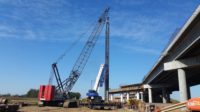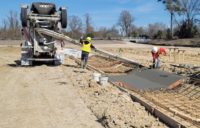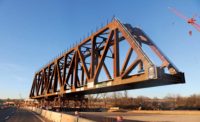A vital interchange that links Interstate 49 to I-220 is nearing completion in Louisiana, marking the penultimate piece of the state’s 36-mile Interstate 49 North project. The $670-million corridor extends from I-220 in Shreveport to the Arkansas state line.
Work is 85% complete on the $225-million interchange, where the project team has had to contend with delays from historically high river flooding, tight deadlines for federal funding and a design that calls for precast segments and architectural features.
After it is completed by late summer or early fall, the only segment left in the I-49 North project will be the I-49 Inner City Connector, a 3.5-mile stretch of interstate still in the environmental assessment stage.
This is the first time in 24 years that the Louisiana Dept. of Transportation and Development (DOTD) has built an interstate interchange. The last time was in 1994, when it constructed an interchange at I-20 and I-49 through the urban section of Shreveport.
“Much has changed and evolved in the realm of construction over the last 24 years, in addition to changes in the city’s population and travel patterns,” says DOTD spokeswoman Erin Buchanan.
The I-49/I-220 project is relying on a standard design-bid-build delivery system with critical path-method scheduling. PCL Construction Services Inc. is the lead contractor on the project.
The state split up construction of the four-level interchange into three separate projects—Segments J, K1 and K2—because of its complexity and size.
Segment K2, which got under way in April 2014, consists primarily of bridges and overpasses, and remains under construction. Segments J and K1 are substantially complete but cannot be opened to traffic until the key components of the K2 connecting project are finished, Buchanan says.
As part of Segment K2, crews are entirely reconstructing I-220 within the project area, including a new road base and paving. The two westbound lanes are complete, and paving on the eastbound lanes is nearing completion.
On Mother Nature’s Clock
Funding from the Federal Highway Administration required that the project meet certain milestones, such as opening the southbound lanes of I-49 Segment J in May 2017. At one point during the construction of Segment K2, crews worked 24 hours a day, seven days a week because of the scope of the project, Buchanan says.
To meet the tight schedule, structural engineering firm TRC had to complete its design in about a year. Eight design teams, including three subcontracted consultants, worked on the plan, says Mike Paul, project manager for TRC.
The project was originally contracted for 882 calendar days, and 1,100 calendar days had been charged as of March, largely due to flooding.
Project teams had to contend with two historic-level floods—one in 2015 and another in 2016. They inundated the construction yard and greatly impeded progress, Buchanan says.
In March, a minor flood hit the project and submerged the construction yard and much of Russell Road, which contractors use to move materials. “We don’t anticipate this event to greatly affect the overall completion timeline,” Buchanan says.
When the floods happened, the construction team sat down as a group to identify what work could be completed when and which areas could be accessed.
“There might only be a half-inch of rain, but [with the mud] it would be pretty difficult to get around in a pickup truck, let alone heavy equipment.”
– Dustin Guszkiewicz, Assistant Project Manager, PCL Construction
Early on, the contractor identified that even small amounts of rainfall would compromise jobsite conditions because of muddy conditions. “There might only be a half-inch of rain, but it would be pretty difficult to get around in a pickup truck, let alone heavy equipment,” says Dustin Guszkiewicz, assistant project manager for Segment K for PCL Construction.
PCL leaned on its roadway contractor, Specialty Trackhoe and Dozer Service Inc., to come up with a plan for installing haul roads and for what the most durable materials would be for supporting 300-ton cranes and segment haulers.
The roadway contractor recommended soil cement haul roads that would mimic the paths of the ramp structures.
A First for Louisiana
The I-49/I-220 interchange is the first post-tensioned, precast segmental bridge built in Louisiana. As a result, the state did not have any existing specifications for this type of bridge construction, so project engineers had to develop them. “That was a significant effort,” says Paul.
Engineers relied for guidance on existing specifications and other contract documents developed by the Florida Dept. of Transportation as well as by the DOTs in Minnesota, Texas and California.
At the outset, the design team needed to determine whether this project would be suitable for segmental construction because of its size, the number of segments and bridge widths. But with nearly 750 segments and similar structure types, the project fit the criteria.
“With precast segmental construction, there are significant up-front costs for the contractor to provide the equipment for the casting beds, the cranes and everything that would transport the segments,” says Paul. “To make it economical, the project needed to be big enough to justify those costs.”
Engineers and planners initially assumed the segment casting yard would be located off site, which in turn would limit span lengths and arrangements because they would need to be trucked to the site. Ultimately, PCL and DOTD found enough room to put the casting yard on site and build all segments there.
All told, the casting yard used 22,000 cu yd of concrete and 5.3 million lb of reinforcing steel.
Varied Ramp Lengths
Design demands required contractors to build an angular interchange to match the curve of I-220, which required long overpass bridges and straddle bents. The entire interchange also had to be shifted to the southeast to avoid a nearby landfill.
The team also developed an economical design for the segmental bridges, given their varied widths. The project has four ramps, including three bridge ramps and one at-grade ramp. Two of the bridge ramps are long—one at 3,300 ft, the other 3,070 ft. By comparison, the third bridge ramp, which crosses a pond, is only 700 ft long.
Widths varied as well. The longest of the bridge ramps needed to be 35.5 ft wide, the shortest 31.5 ft wide. The 3,070-ft ramp varies from 64 ft wide at one end of the bridge and tapers to 42.5 ft wide.
“The consideration was could we design all three bridges so that they were similar enough to make it simple for the contractor to use all the same casting equipment to build the segments for all three bridges. Upon some investigation, we found that this could be done,” Paul says.
Engineers developed the cross-section of the segmental superstructure as a single-cell box with similar core-box dimensions and reinforcement details. The different bridge widths were accommodated by varying the top-slab overhang, or wings, of each bridge.
For the ramp that flares out, the TRC and DOTD considered various structure types but opted for a cast-in-place box girder to match the shape and appearance of the segmental structure type and make it aesthetically pleasing. The span ended up being 127 ft long, with a width that varied from 51 ft to 64 ft; it required 520 cu yd of concrete. A different structure type was needed at the flared portion of this ramp because the segmental template could not accommodate the width.
Architectural features, including artwork and lighting arrays, were required for the project, and engineers had to take steps to incorporate those enhancements into the design.
The engineer brought in Touchstone Architecture to improve the aesthetics. Coordinating with TRC and the DOTD, Touchstone developed a visual quality manual to show which enhancements would be incorporated into the bridges. Completion of the interchange will make it so that drivers between Arkansas and Shreveport will no longer have to exit I-220 to get on I-49.
The interchange also will help make I-49 a complete corridor through the Shreveport and Caddo Parish area.
“Much has been accomplished by DOTD on meeting the goal of completing I-49 from the Arkansas state line southward, but this connection of I-49 segments J, K1 and K2 will provide a vital arterial thoroughfare through Shreveport,” Buchanan says.






